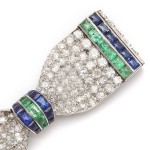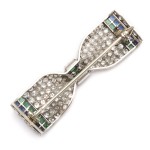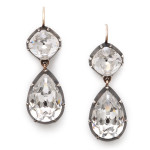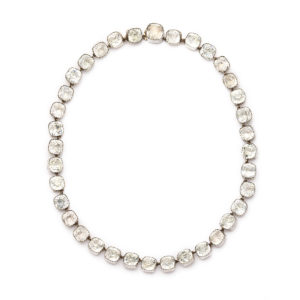Art Deco diamond, emerald, and sapphire bow tie brooch, mounted in platinum.
French, ca. 1920.
Length: 2 inches
$22,000
This item is available for purchase in our online shop and in our 745 Fifth Avenue galleries.


Art Deco diamond, emerald, and sapphire bow tie brooch, mounted in platinum.
French, ca. 1920.
Length: 2 inches
$22,000
This item is available for purchase in our online shop and in our 745 Fifth Avenue galleries.


On April 26, 1687, the famed diarist Samuel Pepys noted that the Duchess of Newcastle wore “many black patches because of pimples about her mouth.â€Â She likely carried them in a patch box, or boite á mouches. Such boxes were often made of gold, tortoise shell, silver, or ivory and fitted with a mirror, adhesive, brush, and compartments for patches. Some feature additional compartments for cosmetics like rouge or kohl.
Made of silk, leather, or taffeta, patches became popular face and body accessories beginning in the 16th century. They came in a range of shapes, including geometric forms, stars, and different phases of the moon. Â Some were even more whimsical, like the shapes of animals and insects. One theory behind the trend is a superstition of moles and their placement, which were admired as marks of beauty.
Donned by both women and men, patches served to accentuate the whiteness of one’s skin and to conceal blemishes. Their placement was a flirtatious language of gestures, as different positions suggested different types of flirtation. A patch near the lips was called the ‘coquette,’ on the forehead, the ‘assassin,’ the ‘roguish’ on the nose, the ‘impassioned’ near the eye and, on the cheek, the ‘gallant.’ Which one are you?

What exactly is paste jewelry? A type of glass, paste easily emulates precious stones, but we must stress that it is by no means imitation anything. Its luster, malleability, and quality of workmanship set it apart from other jewelry materials.
What we know as paste jewelry developed from glass makers experimenting with lead oxide to closely emulate gemstones. In the eighteenth century, glass makers aspired to match the luster of the increasingly popular diamond. Paste jewelry came to be called “Stras,†or “Strass,†after Georges Frédéric Stras, a jeweler from Strasbourg, employed in Paris, who became famous for his paste jewelry and so highly regarded, he was appointed Jeweler to the King.
Paste jewelry was usually foiled and backed in silver. These materials, in addition to the different shapes paste could produce, rendered it a widely coveted jewelry-making material. Considering all these characteristics, it is easy to see how one might cultivate a taste for paste.

745 Fifth Avenue, 4th Floor, NYC 10151
1.212.752.1727
Terms of Sale | Terms of Use | Privacy Policy
© A La Vieille Russie | Site by 22.